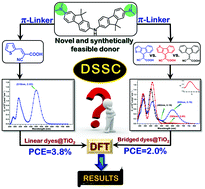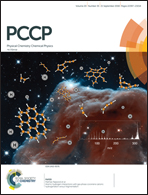The impact of heteroatom substitution on cross-conjugation and its effect on the photovoltaic performance of DSSCs – a computational investigation of linear vs. cross-conjugated anchoring units†
Abstract
The unusual bonding pattern and proximal heteroatom substitution in π-cross conjugation produced distinct changes in the energy levels and photophysical behaviour of the dyes. To seek an understanding of the origin of these fluctuations, we have carried out a detailed computational investigation on a series of D–π1–π2 (A1)–A2 structured dyes comprised of common donor-spacer (auxiliary acceptor) units but varied the anchoring parts. In this study, we introduced a novel dimethylamino substituted fluorene-based triarylamine donor unit and evaluated its donating strength. Based on the comparison of DFT computed energy levels with experimental results, we have proposed an orbital splitting pattern to explain the energy level and photophysical properties of the linear vs. cross-conjugated dyes with respect to the linking position of the anchoring unit and benzo[1,2,5]thiadiazole (BTD) substitution. The smallest HOMO–LUMO gap of B3 mainly originated from the weak overlap of the directionality mismatch of the orbital interaction imposed by cross-conjugation. The inefficient overlap in B3 can possibly influence the energy levels but failed to enhance the charge transfer transitions upon photoexcitation. On the other hand, β-heteroatom substitution in bridged dyes partially enhanced π-delocalization over the cross conjugation and produced a significant ICT absorption with an optoelectronic response in the NIR region. BTD acceptor substitution increased the HOMO–LUMO gap of the bridged dyes. NBO analysis was performed to corroborate our predictions. DOS-PDOS analysis of the dyes@TiO2 was employed to investigate the electron injection rate of linear vs. bridged dyes. The anchoring pattern and large torsional deviation of the carboxylate anchoring group upon TiO2 adsorption drastically decreased the photovoltaic performance of the bridged dyes. The results obtained from this study provided a detailed understanding of how to surmount the cross-conjugation with the aid of β-heteroatom substitution. These design guidelines would be helpful in developing novel NIR dyes with better hole mobility for various optoelectronic applications. Furthermore, π-delocalization over the cross-conjugation concept opens a new pathway in the field of functional molecular devices to increase the charge conductance over several orders of magnitude with a significant reduction of destructive quantum interference at the molecular junction.



 Please wait while we load your content...
Please wait while we load your content...